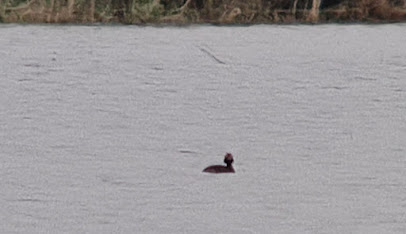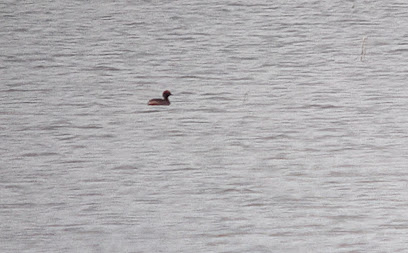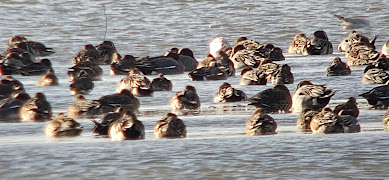For the second time this winter, some of the local birders had expressed interest in a duck in the LDV that was showing characters of Lesser Scaup.This would be a first for the York area and after several years of increasing rarity in the UK, this winter had seen a reverse in fortunes, with a real influx, so if we were going to get one, surely this would be the year. With deep flooding since November, the valley has supported good numbers of diving ducks, including several Greater Scaup, so if any Lesser Scaup was passing, there would be a good chance of it dropping in.
The first bird to get local birder's pulses racing was a female type, but photos showed that to be a Tufted Duck with extensive white feathering around the bill base. Female Tufties can show this frequently, but this bird was at the extreme end, but the shape of the patch was not right for LS, nor was the colouration of the mantle and flanks. Whilst some claimed it had some Scaup parentage, I couldn't see that myself; it just looked like a Tuftie to me, with standard upperparts and flanks, head shape and size.
Fast-forward to the last week or so, the valley was deeply flooded yet again and distant views of a drake Scaup-type on Wheldrake Ings had generated a lot of interest. Towards the end of last week the water had dropped enough for birders to get to Tower Hide and some rather record shots showed a bird with some really pro-Lesser Scaup features: the head shape had the classic peak to the rear-crown, it looked fairly small and the back a little darker than a nearby drake Greater Scaup. This looked good! Comments from birders on site were very positive but unfortunately, the bird was feeding on Swantail Ings, rather distant from Tower Hide so hadn't been nailed. If only we could access Swantail Hide!
The watery view from Tower Hide.
I was keen to get down there and have a look for myself, and managed to do so on a rather wet Friday afternoon. Unsurprisingly, nobody else was present and wading through the floodwater in pouring rain made me start to doubt my own sanity. However, the chance to clinch a first for York was plenty of motivation to battle down to Tower. I soon found the Scaups feeding actively with the other diving ducks. The light was bad, it was raining and the ducks were diving frequently.
This wasn't going to be easy - or even possible! The 'Lesser' stood out from its larger cousin and I could see why it had caused some excitement. The headshape looked spot on, as it had in photos I'd seen, with a nice peak at the rear and a steep forehead. The bill was parallel-sided and blue, perhaps paling towards the tip. It was difficult to discern the extent of any black on the tip at first. The upperparts appeared mid-grey and uniform, clearly darker than the Greater Scaup nearby, but I couldn't tell if this colouration was due to thick vermiculations (lines), as you'd expect in Lesser Scaup, or just a mid-grey base colour, more typical of a hybrid.
'Lesser' Scaup on right hand side, with the drake Greater Scaup in the middle and the third bird on the left (I will mention that in a minute).
After a while, the two decided to have a preen and clambered on to some floating vegetation. The 'Lesser' looked smaller than the Greater but I wasn't convinced it was really small enough. I'd noticed that when they were diving, it was sometimes difficult to tell which bird I was looking at - the size difference wasn't really what I would have expected. This rang an alarm bell with me and sowed the first seed of doubt in my mind. Secondly, that grey back looked very smooth and didn't really seem to have the same base colour as the back of the Greater...
Drake Greater Scaup (left) and 'Lesser', facing away. You can clearly see the difference in back colour, despite the terrible light.
After a heavy downpour, the sun came out briefly. The Scaups immediately started bathing and splashing around. I stared hard to see if the bird would do a wingflap and reveal its two tone wingbars (Lesser should have a grey wingbar across the black primaries, and a white bar across the secondaries. Greater Scaup and hybrids tend to have white wingbars throughout. Sure enough, the 'Lesser' did three wingflaps but managed to be facing towards me every time! Typical.
With better light, I noticed to my dismay that there seemed to be black on the tip of the bill. A pure drake Lesser Scaup should have a tiny amount of black on the nail of the bill. This bird seemed to show black on the nail and bleeding on to the sides of the tip. This feature alone ruled out Lesser Scaup, indicating mixed parentage, and made squinting through my scope at the other features rather academic. So, close but no cigar and Lesser Scaup still evades the York list.
A little while later, I came across a third Scaup-type, which until that moment I hadn't noticed. The Lesser type seemed to stick closely to the Greater Scaup, whereas this bird seemed happy hanging out with the Tufties. This third bird also looked a little like a Lesser Scaup though not as convincingly. I then got myself very confused and realised perhaps I had been watching the original hybrid and it had just moved along the flock. Wierd. Either way, this bird wasn't a Lesser Scaup either.
I put out the rather disappointing news, although caveating it to say if the bird was seen much closer and the features were in fact spot-on, then I would be surprised, but pleased to be proved wrong.
...
3rd March.
I found myself at Wheldrake again in rather better light this afternoon. Bumping into Duncan, we walked down the riverside path, which was disgustingly muddy and flooded, to the viewing screen. The three Scaup were still on Swantail Ings, but marginally closer. I was able to confirm my suspicions that the bird was in fact a hybrid and the third bird seemed also to be a hybrid although a little less Lesser Scaup like. It was still a little smaller than the Greater Scaup, had the same dark back but the headshape was between Lesser and Greater, with an insignificant rear peak. Perhaps these two hybrids were siblings? So it seems we have one Greater Scaup and two Aythya hybrids, presumably both Pochard x Tufted Duck. It is massively frustrating that this has been the result, but hopefully the genuine article will turn up this spring as birds begin to move north. A pair of Lesser Scaups turned up in Lancashire yesterday and it was interesting to see all the salient features on these, compared to the two birds we have analysed in the LDV this winter. The distances we have had to deal with have been really challenging, so hopefully when a real Lesser turns up, it will be on the pool so we can get a better look!

L to R: Greater Scaup, second hybrid, original hybrid (facing away) and two Tufted Ducks. The second hybrid is clearly smaller than the Greater, but bigger than the Tufties.
Among the Tufties, the original hybrid is at the front on the left, with the Greater two ducks to the right. The secodnd hybrid is to the rear facing left.
L to R: Greater Scaup and original hybrid. The second hybrid is behind the Greater and mostly obscured.
Original hybrid with the Greater Scaup. Note how the hybrid is not that much smaller, it's back is quite a flat mid-grey, and doesn't really have the same base colour as the Greater; no coarse vermiculations can be seen, which should be visible from this range. In the upper photo, you get a suggestion of the black on the bill tip, though it is not easy to see in the pic.
It is possible that the first hybrid is the bird seen previously at Slaynes Lane in South Yorkshire. This was also considered to be a Lesser Scaup until closer views confirmed it was a hybrid. So it is not just us York birders who get frustrated by these Aythyas! The very first Lesser Scaup I twitched in the UK was at Gouthwaite Reservoir in the late 1980s, not long after the first UK record. By the time my Dad and me had arrived, birders had identified that bird as a hybrid. So, this pitfall is always on my mind with this species. I have seen about a dozen in the UK over the years, but only one in Yorkshire, so it would be great to get one here in York. One day soon, hopefully!
...
I stayed on to do the gull roost and it was interesting to see how many of the Black-headed Gulls had acquired their hoods now. A partially leucistic snowy-white BHG came in to roost, the first I've seen this winter. A first-winter Lesser Black-backed Gull came in too, but very few large gulls at all.



















































